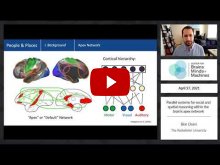 April 27, 2021 - 4:00 pm to 5:30 pm
April 27, 2021 - 4:00 pm to 5:30 pm Dr. Ben Deen (Rockefeller University)
Host: Prof. Winrich Freiwald (Rockefeller University)
Abstract: What is the cognitive and neural architecture of core reasoning systems for understanding people and places? In this talk, we will outline a novel theoretical framework, arguing that internal models of people and places are implemented by two systems that are separate but parallel, both in cognitive structure and neural machinery. Both of these systems are anatomically positioned at the apex of the cortical hierarchy, and both interact closely with the medial temporal lobe declarative memory system, to update models of specific familiar people and places based on experience. Next, we test foundational predictions of this framework with a human fMRI experiment. Participants were scanned on tasks involving visual perception, semantic judgment, and episodic simulation of close familiar people and places. Across the three tasks, conditions involving familiar people and places elicited responses in distinct but parallel networks of association cortex, including zones within medial prefrontal cortex, medial parietal cortex, and the temporo-parietal junction. Lastly, we address the question of how these systems emerged in evolution. By assessing fMRI responses in nonhuman primates viewing images of familiar and unfamiliar animals and objects, we identify subregions of medial prefrontal cortex with a similar profile of functional response and anatomical organization to human social reasoning areas. These results indicate that the cognitive and neural architecture supporting human social understanding may have emerged by a modification of existing cortical systems for spatial cognition and long-term memory.
Zoom link: https://mit.zoom.us/j/96168764797?pwd=bExnNjZ6THFMLzArcHB4TzlNaFBNZz09

